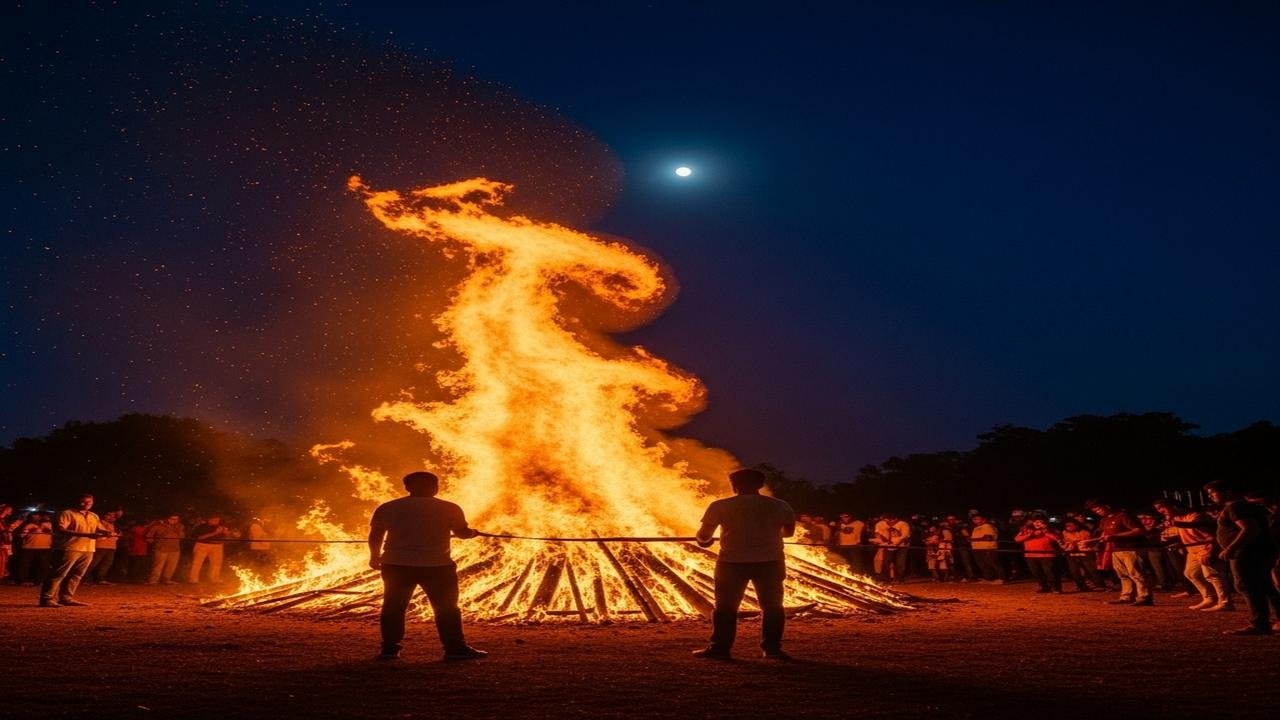Holika Dahan Phalguna Full Moon Bonfire Before Holi

Background and myth
Holika Dahan is the nighttime bonfire that opens the festival of Holi. The ritual commemorates a well-attested Purāṇic narrative: Hiranyakashipu, a powerful king and adversary of Viṣṇu; his son Prahlada, a steadfast devotee of Viṣṇu; and Holika — a woman often described as Hiranyakashipu’s sister — who is associated with a boon that made her immune to fire. According to many tellings (the story appears in variants across the Purāṇas and in the Śruti-Śāstra retellings), Holika sits on a pyre with Prahlada in an attempt to kill him, but the protective power fails and Holika is consumed while Prahlada emerges unharmed. The image is vivid: devotion (bhakti — loving devotion) surviving the flames that destroy arrogance and adharma (that which runs counter to righteous duty).
When the ritual happens
Holika Dahan is observed on the evening before Holi, typically on the full-moon (pūrṇimā) tithi of the lunar month of Phālguna in the North Indian calendar. Local calendars, community priests and regional customs can shift the precise time by a few hours; in many places the bonfire takes place after sunset, when pūrṇimā tithi is in force. As with all lunar-timed rituals, people consult their panchāṅga (almanac) for the correct muhūrta (auspicious moment).
How it is performed, simply
- Communities gather in the evening and arrange a pyre of wood, cow dung cakes, and agricultural residues.
- Some places place an effigy of Holika on the pyre; others keep the circle free and offer grains, coconuts and flowers to the fire.
- Priests or elders recite mantras or chant narratives about Prahlada’s faith; villagers circumambulate the fire and throw offerings into it.
- After the flames subside, people take home a charred piece of wood or ash as a symbolic blessing, and the next day is the riotous play with colours (Holi proper).
Caution: take care with open flames and smoke; those with respiratory problems should avoid close proximity to bonfires.
Layers of meaning
- Ritual purification: Fire (agni) is a classical purifier in Vedic and later ritual worlds. The bonfire marks the end of a cycle — winter’s decline — and a preparatory cleansing before the spring festival.
- Triumph of devotion: In Vaiṣṇava readings, Prahlada’s survival is proof that bhakti protects the sincere aspirant even against worldly power. Commentators on devotional texts often use the episode to teach surrender to God over reliance on royal power or magical boons.
- Ethical and political symbol: Holika’s burning is commonly read as the destruction of tyranny and pride. In popular retellings, Hiranyakashipu’s arrogance and refusal to accept moral law are put to the test — and found wanting.
- Psychological reading: Some modern interpreters treat the event as inner work: the flames symbolise the burning away of ego, greed and habitual tendencies that stand between a person and ethical life.
- Seasonal and agrarian sense: Holika Dahan aligns with the agricultural year. The ritual uses leftover straw and twigs from the harvest and marks community preparation for the new sowing season — a practical as well as symbolic clearing for renewal.
- Gender and power: Holika’s figure raises difficult questions. In many tellings she is a villain; in others she is a woman misused by patriarchal ambition. Feminist and Śākta readings sometimes reclaim the feminine energy as ambivalent — powerful but misdirected. The story thus opens conversation about how religious narratives portray women and authority.
- Communal repair and social memory: The bonfire is a communal event that repairs social ties. In diverse towns and hamlets it functions as a public, seasonal theatre where stories are retold and local identities renewed.
Scriptural and regional variations
While the core story is popularly associated with the Purāṇic cycle about Prahlada and Hiranyakashipu, regional practices vary widely. In parts of North India Holika is made into an effigy and burned; in other places the emphasis is on offerings to fire without dramatizing a person. In South India there are separate springtime bonfires and dramas (for instance, the Kama Dahanam legend involving Kāmadeva and Śiva) that are similar in function but different in narrative content. Śaiva, Vaiṣṇava and local folk traditions each bring their own emphases: some stress the victory of Viṣṇu; others stress seasonal purification or local goddess stories.
Contemporary conversations
Today Holika Dahan also invites debate and reinterpretation. Environmental concerns push communities toward cleaner, smaller fires and away from non-biodegradable effigies. Social critics read the story through lenses of caste and social justice, asking who is represented as villain and why. Feminist readers ask whether Holika’s agency is properly explored or simply cast as evil. Many urban households frame the bonfire as a ritual of inner renewal rather than literal triumphalist burning.
Closing reflection
Holika Dahan is at once simple and deep: a communal bonfire, a Purāṇic drama, a seasonal marker, and a mirror for moral reflection. Its longevity derives from that plurality. Whether one approaches the night as a devotional act, a symbolic purge of the ego, an agricultural rite or a cultural theatre, the core image endures — from fire emerges a community ready to welcome spring, to remember that power without conscience is combustible, and that humility and devotion have a peculiar resilience.
